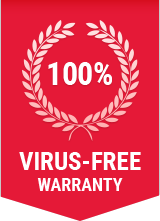What is KillServer.dll?
The file named KillServer.dll is developed by an unknown source. The file is not associated with any software and is considered to be a threat because of the lack of a known developer. It can be hijacked by a virus at any time without warning. However, there are no known instances of any attack so far. The threat level of the file is 3.
KillServer.dll is located in c:\windows\system32. The total size of the file and the latest version of the program available cannot be found in any records. It is a non-system process which can readily be removed without negative consequences. The file is not essential for Windows operating system to run.
Affected Platform: Windows OS
How to check if your computer is infected with KillServer.dll malware?
If your system is affected by KillServer.dll malware, you will notice one or several of the symptoms below:
- KillServer.dll occupies an unusually large CPU memory
- Erratic internet connection
- Your browser is bombarded with annoying popup ads
- Computer screen freezes
- PC's processing speed suffers
- You are redirected to unknown websites
To pinpoint the virus file location, take the following steps:
Step 1: Press CTRL+ALT+DEL keys at once to open Task Manager.
Step 2: If you notice the file located outside C:\Program Files, you should run an antivirus scan to get rid of the malware.
How to remove KillServer.dll malware from system using Comodo Cleaning Essentials?
You can either choose to remove KillServer.dll and other malwares using Comodo Antivirus, or Comodo Cleaning Essentials (CCE) – both of which are absolutely free to download! CCE is a set of computer security tools designed to help you identify and remove malwares and unsafe processes from an infected computer.
To remove malwares using CCE, take the following steps:
- Check the system requirements and download the feature-rich CCE suite for free.
- After installation, choose the type of scan you want to perform. CCE offers 3 scan options to get rid of malwares from a PC:
- Smart Scan: Does a scan on critical areas of your system.
- Full Scan: Does a complete scan of your system.
- Custom Scan: Does a scan only on selected items.
The process to initiate the above mentioned scans are self-explanatory and thus, easy-to-use.
Additionally, it's recommended that you approve of any updates that the CCE will prompt you about to ensure it does a better job of identifying all the latest threats.
- Click 'Next' to view the results.
Regardless of the type of scan you choose, the results will sometimes show false positive (flagging files that are actually safe), which has to be ignored. Only select the files you want to get rid of.
4. Click 'Apply' to apply the selected operations to the threats. The selected operations will be applied.
| No. | Company | File Type | SHA1 | MD5 | Malware Name |
Digitally Signed |
File Version |
Product Version |
Submitted From |
Malware Behavior |
|---|
- 4 items per page
- 8 items per page
- 16 items per page
- 32 items per page
| No. | Company | File Type | SHA1 | MD5 | Digitally Signed |
File Version |
Product Version |
Submitted From |
|---|---|---|---|---|---|---|---|---|
| 1 | N/A | Executable | 1b4ccfcfd3f31a85 eac1031953a7df0d 885c837a |
2d28cb7f0dc9890e ad57701c1775de8b |
No | N/A | N/A |  Internal Submission Internal Submission |
- 4 items per page
- 8 items per page
- 16 items per page
- 32 items per page








